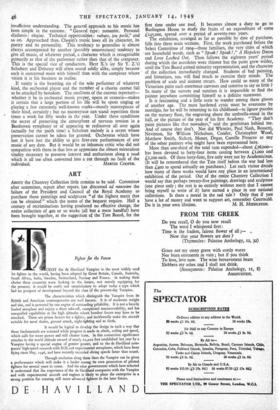ART
ABOUT the Chantrey Collection little remains to be said. Committee after committee, report after report, has discussed ad nauseam the failure of the President and Council of the Royal Academy to purchase those paintings and sculptures " of the highest merit that can be obtained " which the terms of the bequest require. Half a century of recriminations having produced no effective change, the entire collection of 400 or so works (all but a mere handful) have been brought together, at the suggestion of the Tate Board, for the
first time under one roof. It becomes almost a duty to go to Burlington House to study the fruits of an expenditure of some £145,000, spread over a period of seventy-two years.
The exhibition, arranged as far as possible by date of purchase, falls into three main sections. First, the work purchased before the Select Committee of 1904—those familiars, the very titles of which -are household words, such as "Speak ! Speak ! ," A Hopeless Dawn and Love Locked Out. Then follows the eighteen years' period during which the anecdotes wore thinner but the paint grew wilder, until the Tate Board gained minority representation, and the character of the collection immediately changed. Students of bad painting, and historians, too, will find much to exercise their minds. The problem of scale and content recurs. How could so many of the Victorians paint such enormous canvases and contrive to say so little ? In many of the sunsets and sunrises it is impossible to find the painter anywhere committing himself to a definite statement.
It is fascinating and a little eerie to wander among these ghosts of another age. The most hardened cynic must be overcome by nostalgia, for he will be returning to his childhood—to jigsaw puzzles on the nursery floor, the engraving above the umbrella-stand in the hall, or the picture of the year of his first Academy. " They don't paint pictures like that nowadays," said the gentleman behind me. And of course they don't. Nor did Whistler, Paul Nash, Rossetti, Nevinson, Sir William Nicholson, Conder, Christopher Wood, Matthew Smith, Sickert, Monet, Degas, Camille Pissarro or any of the other painters who might have been represented here. More than one-third of the total sum expended—about £56,000— has been devoted to forty-four items costing between £I,000 and £2,zoo each. Of these forty-four, five only were not by Academicians. (It will be remembered that the Tate itself before the war had less than £400 to spend annually on purchases.) Let each visitor decide how many of these works would have any place in an international exhibition of the period. Out of the entire Chantrey Collection I would say that perhaps twenty-five paintings, drawings and sculpture (one piece only ; the rest is so entirely without merit that I cannot bring myself to write of it) have earned a place in our national collections. Is there a moral in the sad tale Only that if you have a lot of money and want to support art, remember Courtauld.


































 Previous page
Previous page